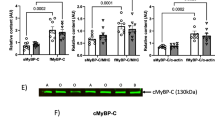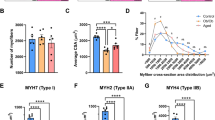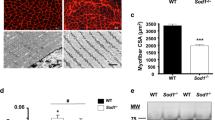Abstract
Glycation, a non-enzymatic addition of reducing sugars to ε-amino groups of proteins, is a post-translational modification that results in the formation of irreversible advanced glycation end products (AGEs). Ageing related decline in myofibrillar protein function is effected by a number of structural and functional modifications including glycation. Functional properties of skeletal muscles, such as maximum velocity of unloaded shortening, are known to be profoundly affected by ageing at the motor unit, cellular and tissue levels. However, the contribution of protein modifications to a decline in muscle function is not well understood. In this study we measured AGEs of intracellular and sarcolemmal proteins, using an anti-AGE antibody in soleus (SOL) and extensor digiotorum longus (EDL) muscles of male and female rats of five different age groups. Using a fluorescent secondary antibody to visualize AGEs in the confocal microscope, we found that myosin is glycated in both fiber types in all age groups; an ageing related increase in AGEs was observed in both intracellular and sarcolemmal regions in all age groups, with the exception of sarcolemma of SOL (unchanged) and EDL (reduced) in female rats; the greatest concentration of AGEs was found intracellularly in the SOL of the oldest age group (27–30) of females. While an ageing related decline in motor properties can be partially attributed to the observed increase in myofibrillar protein glycation, our results also indicate that intracellular and the less well studied sarcolemmal protein modification likely contribute to an aging-related decline in muscle function. Further studies are required to establish a link between the observed ageing related increase in glycation and muscle function at the motor unit, cellular and tissue levels.




Similar content being viewed by others
References
Avigad G, Kniep A, Bailin G (1996) Reaction of rabbit skeletal myosin with d-glucose 6-phosphate. Biochem Mol Biol Int 40:273–284
Bai DH, Moon TW, Lopez-Casillas F, Andrews PC, Kim KH (1989) Analysis of the biotin-binding site on acetyl-CoA carboxylase from rat. Eur J Biochem 182:239–245
Balagopal P (1997) Effects of aging on in vivo synthesis of skeletal muscle myosin heavy-chain and sarcoplasmic protein in humans. Am J Physiol 273:E790–E800
Barany M (1967) ATPase activity of myosin correlated with speed of muscle shortening. J Gen Physiol 50(Suppl):197–218
Brownlee M (1995) Advanced protein glycosylation in diabetes and aging. Annu Rev Med 46:223–234
Degens H, Yu F, Li X, Larsson L (1998) Effects of age and gender on shortening velocity and myosin isoforms in single rat muscle fibres. Acta Physiol Scand 163:33–40
Edstrom L, Larsson L (1987) Effects of age on contractile and enzyme-histochemical properties of fast- and slow-twitch single motor units in the rat. J Physiol (Lond) 392:129–145
Fujimori E (1989) Cross-linking and fluorescence changes of collagen by glycation and oxidation. Biochim Biophys Acta 998:105–110
Giulian GG, Moss RL, Greaser M (1983) Improved methodology for analysis and quantitation of proteins on one- dimensional silver-stained slab gels. Anal Biochem 129:277–287
Hook P, Li X, Sleep J, Hughes S, Larsson L (1999) In vitro motility speed of slow myosin extracted from single soleus fibres from young and old rats. J Physiol 520(Pt 2):463–471
Hook P, Sriramoju V, Larsson L (2001) Effects of aging on actin sliding speed on myosin from single mouse, rat and human skeletal muscle cells. Am J Physiol Cell Physiol 280:C782–C788
Horiuchi S, Araki N, Morino Y (1991) Immunochemical approach to characterize advanced glycation end products of the Maillard reaction. Evidence for the presence of a common structure. J Biol Chem 266:7329–7332
Howard EW, Benton R, Ahern-Moore J, Tomasek JJ (1996) Cellular contraction of collagen lattices is inhibited by nonenzymatic glycation. Exp Cell Res 228:132–137
Hunt JV, Wolff SP (1991) The role of histidine residues in the nonenzymic covalent attachment of glucose and ascorbic acid to protein. Free Radical Res Commun 14:279–287
Kuleva NV, Kovalenko ZS (1997) Change in the functional properties of actin by its glycation in vitro. Biochemistry (Mosc) 62:1119–1123
Kuzuya M, Asai T, Kanda S, Maeda K, Cheng XW, Iguchi A (2001) Glycation cross-links inhibit matrix metalloproteinase-2 activation in vascular smooth muscle cells cultured on collagen lattice. Diabetologia 44:433–436
Lal S, Chithra P, Chandrakasan G (1996) The possible relevance of autoxidative glycosylation in glucose mediated alterations of proteins: an in vitro study on myofibrillar proteins. Mol Cell Biochem 154:95–100
Larsson L (1995) Motor units: remodeling in aged animals. J Gerontol A Biol Sci Med Sci 50:91–95
Larsson L, Edstrom L (1986) Effects of age on enzyme-histochemical fibre spectra and contractile properties of fast- and slow-twitch skeletal muscles in the rat. J Neurol Sci 76:69–89
Larsson L, Muller U, Li X, Schiaffino S (1995) Thyroid hormone regulation of myosin heavy chain isoform composition in young and old rats, with special reference to IIX myosin. Acta Physiol Scand 153:109–116
Larsson L, Li X, Frontera WR (1997a) Effects of aging on shortening velocity and myosin isoform composition in single human skeletal muscle cells. Am J Physiol 272:C638–649
Larsson L, Li X, Yu F, Degens H (1997b) Age-related changes in contractile properties and expression of myosin isoforms in single skeletal muscle cells. Muscle Nerve Suppl 5:S74–78
Li X (1996) Effects of ageing on contractility and myosin composition of rat and human skeletal muscles and muscle cells. With special reference to muscle adaptability. In Karolinska Institute, Karolinska Institute, Stockholm
Li M, Yagi N, Iwamoto H, Ogilvie H, Konstantin A, Bergquist J, Larsson L (2013) Aging-related modifications of skeletal muscle myosin: effects on structure and function (in manuscript)
Makita Z, Radoff S, Rayfield EJ, Yang Z, Skolnik E, Delaney V, Friedman EA, Cerami A, Vlassara H (1991) Advanced glycosylation end products in patients with diabetic nephropathy. N Engl J Med 325:836–842
Mooradian AD, Wong NC (1991) Molecular biology of aging. Part II: a synopsis of current research. J Am Geriatr Soc 39:717–723
Ramamurthy B, Hook P, Jones AD, Larsson L (2001) Changes in myosin structure and function in response to glycation. Faseb J 15:2415–2422
Rome LC, Sosnicki AA, Goble DO (1990) Maximum velocity of shortening of three fibre types from horse soleus muscle: implications for scaling with body size. J Physiol (Lond) 431:173–185
Schiaffino S, Gorza L, Sartore S, Saggin L, Ausoni S, Vianello M, Gundersen K, Lomo T (1989) Three myosin heavy chain isoforms in type 2 skeletal muscle fibres. J Muscle Res Cell Motil 10:197–205
Sell DR, Nelson JF, Monnier VM (2001) Effect of chronic aminoguanidine treatment on age-related glycation, glycoxidation, and collagen cross-linking in the Fischer 344 rat. J Gerontol A Biol Sci Med Sci 56:B405–411
Shaw SM, Crabbe MJ (1994a) Monitoring the progress of non-enzymatic glycation in vitro. Int J Pept Protein Res 44:594–602
Shaw SM, Crabbe MJ (1994b) Non-specific binding of advanced-glycosylation end-products to macrophages outweighs specific receptor-mediated interactions. Biochem J 304(Pt 1):121–129
Syrovy I, Hodny Z (1992) Non-enzymatic glycosylation of myosin: effects of diabetes and ageing. Gen Physiol Biophys 11:301–307
Towbin H, Staehelin T, Gordon J (1979) Electrophoretic transfer of proteins from polyacrylamide gels to nitrocellulose sheets: procedure and some applications. Proc Natl Acad Sci USA 76:4350–4354
Tsuru M, Nagata K, Jimi A, Irie K, Yamada A, Nagai R, Horiuchi S, Sata M (2002) Effect of AGEs on human disc herniation: intervertebral disc hernia is also effected by AGEs. Kurume Med J 49:7–13
Turk Z, Misur I, Turk N, Benko B (1999) Rat tissue collagen modified by advanced glycation: correlation with duration of diabetes and glycemic control. Clin Chem Lab Med 37:813–820
Verbeke P, Perichon M, Borot-Laloi C, Schaeverbeke J, Bakala H (1997) Accumulation of advanced glycation endproducts in the rat nephron: link with circulating AGEs during aging. J Histochem Cytochem 45:1059–1068
Verzijl N, DeGroot J, Ben ZC, Brau-Benjamin O, Maroudas A, Bank RA, Mizrahi J, Schalkwijk CG, Thorpe SR, Baynes JW, Bijlsma JW, Lafeber FP, TeKoppele JM (2002) Crosslinking by advanced glycation end products increases the stiffness of the collagen network in human articular cartilage: a possible mechanism through which age is a risk factor for osteoarthritis. Arthritis Rheum 46:114–123
Watanabe H, Ogasawara M, Suzuki N, Nishizawa N, Ambo K (1992) Glycation of myofibrillar protein in aged rats and mice. Biosci Biotechnol Biochem 56:1109–1112
Williams JH, Ward CW (1998) Changes in skeletal muscle sarcoplasmic reticulum function and force production following myocardial infarction in rats. Exp Physiol 83:85–94
Wu JT, Tu MC, Zhung P (1996) Advanced glycation end product (AGE): characterization of the products from the reaction between d-glucose and serum albumin. J Clin Lab Anal 10:21–34
Yu F, Degens H, Li X, Larsson L (1998) Gender- and age-related differences in the regulatory influence of thyroid hormone on the contractility and myosin composition of single rat soleus muscle fibres. Pflugers Arch 437:21–30
Acknowledgments
We are grateful to Dr. Bertrand Friguet for providing us with the anti-AGE-RNAse antibody. This study was supported by grants from the European Commission (MyoAge, EC Fp7 CT-223756 and COST CM1001), STINT, Swedish Research Council (8651), NIH (AR 045627, AR 047318, AG014731), and King Gustaf V and Queen Victoria’s Foundation to L.L.
Author information
Authors and Affiliations
Corresponding author
Rights and permissions
About this article
Cite this article
Ramamurthy, B., Larsson, L. Detection of an aging-related increase in advanced glycation end products in fast- and slow-twitch skeletal muscles in the rat. Biogerontology 14, 293–301 (2013). https://doi.org/10.1007/s10522-013-9430-y
Received:
Accepted:
Published:
Issue Date:
DOI: https://doi.org/10.1007/s10522-013-9430-y




